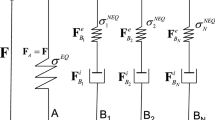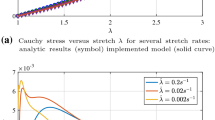Abstract
Although polymer composition of elastomeric material provides excellent performance under different loading cases, the highly nonlinear and rate-dependent behavior of these materials creates serious challenges to investigate the mechanical behavior of them. In this study, the hyperviscoelastic behavior is simulated by implementing the rate-dependent factors into the Mooney–Rivlin strain density potential with nine parameters and material properties are characterized by performing the uniaxial tension loading under different strain rates from 0.001 to 0.33/s for three different shore hardness. In the present study, a developed user-defined subroutine connected to Abaqus commercial finite-element code was employed to simulate the hyperviscoelastic behavior of polyurethane elastomers under dynamic uniaxial tensile loading. The uniaxial tension model is used to predict the hyperviscoelastic behavior and damage evolution of the material. Verification of the FEA simulation model with the experimental data provides a good agreement between the numerical and experimental results.







Similar content being viewed by others
References
ASTM D-412 (2021) Standard test methods for vulcanized rubber and thermoplastic elastomers—tension
Bonet J, Wood RD (1997) Nonlinear continuum mechanics for finite element analysis. Cambridge University Press, Cambridge
Crocker LE, Duncan BC, Hughes RG (1999) Hyperelastic modelling of flexible adhesives. npl report cmmt(A)183
Damanpack AR, Bodaghi M, Liao WH (2017) A robust hyper-elastic beam model under bi-axial normal-shear loadings. Int J Non-Linear Mech 95:287–295
Guo Z, Sluys LJ (2008) Constitutive modelling of hyperelastic rubber-like materials. Heron 53(3)
Kolling S, Bois PAD (2005) A simplified rubber model with damage. In: LSDYNA Anderverforum, Bamberg
Kumar N, Rao VV (2016) Hyperelastic Mooney–Rivlin model: determination and physical interpretation of material constants. MIT Int J Mech Eng 6(1):43–46
Lev Y, Volokh K (2016) Modeling crack propagation in rubber. In: 14th international LS-DYNA conference
Mohotti D, Ali M, Ngo T, Lu J, Mendis P (2014) Strain rate dependent constitutive model for predicting the material behaviour of polyurea under high strain rate tensile loading. Mater Des 53:830–837
Nair AU, Lobo H, Bestelmeyer AM (2009) Characterization of damage in hyperelastic terials using standard test methods and abaqus. In: SIMULIA customer conference
Nowak Z (2008) Constitutive modelling and parameter identification for rubber-like materials. Eng Trans 56(2):117–157
Shahzad M, Kamranb A, Siddiquia MZ, Farhan M (2015) Mechanical characterization and FE modelling of a hyperelastic material. J Mater Res 18:918–924
Somarathna HMCC, Raman SN, Mohotti D, Mutalib AA, Badri KH (2020) Hyper-viscoelastic constitutive models for predicting the material behavior of polyurethane under varying strain rates and uniaxial tensile loading. Construct Build Mater 236:117417
Author information
Authors and Affiliations
Corresponding author
Ethics declarations
Conflict of interest
On behalf of all the authors, the corresponding author states that there is no conflict of interest.
Additional information
Publisher's Note
Springer Nature remains neutral with regard to jurisdictional claims in published maps and institutional affiliations.
Rights and permissions
About this article
Cite this article
Jahanmardi, M., Toudeshky, H.H. & Goodarzi, M.S. Experimental hyperviscoelastic constitutive model for numerical study of elastomer materials. Appl Nanosci 12, 3655–3663 (2022). https://doi.org/10.1007/s13204-022-02554-y
Received:
Accepted:
Published:
Issue Date:
DOI: https://doi.org/10.1007/s13204-022-02554-y




